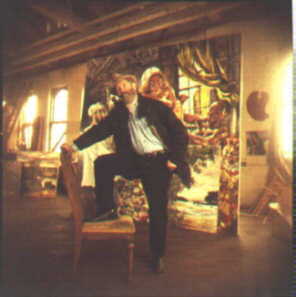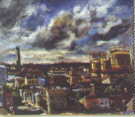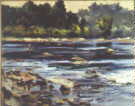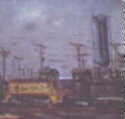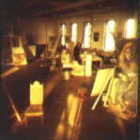"Cultivate mess," he says. "For me, art comes
out of mess.
Disorder is crucial to discovery."
Today's painting will be a still-life: a few lemons (one of them
halved), a plate, a silver teapot, and some whole fish just
purchased at Baltimore's Lexington Market. He works out the
arrangement he wants, then begins the underpainting, sketching
the basic composition in brown tones, laying in the darks that
will underlie the color. "This is like setting up a scaffolding,"
he says. "You can just paint direct. There's more freshness that
way. But there's more richness this way." He doesn't talk much
while he works. The only sounds are the moist sucking noises of
his pipe and the scrape of his brushes against the canvas.
IN A TINY OFFICE IN THE FRONT
ROOM of his house, Middleman and I spend one
morning talking about his youth. There's barely room for our two
chairs. Art books, papers, slides, and unopened mail are stacked
on every available surface. Atop the shelving unit that separates
the office from his wife's studio rests a violin; Middleman plays
second violin in the Hopkins Symphony Orchestra. The family dog,
a golden retriever named Balthus, silently checks me out, accepts
having his head scratched, then ambles back to a favored spot on
the kitchen floor. When Ruth sticks her head into the room, Raoul
says, "Here's my kept woman."
"Well kept," she says, grinning, then sets off on an errand.
Her husband was born in Baltimore, the only child of Paul and
Betty Middleman. He describes his mother as an eccentric, his
father as a perfectionist: "I remember going into the attic and
finding boxes of his school papers, with nothing less than 100 on
them. Devastating for a young person to find that.
"We had a very difficult relationship. He thought I was a bum, as
did most of my family. I understand this. Ours was a Jewish
immigrant family that had made some headway into the culture.
Then I come along and thumb my nose at all that, wanting to be an
artist, which is a childish, ego sort of thing from their
standpoint. My father got proud of me only later."
As he recalls growing up in the Ashburton section of the city, a
few miles north of Druid Hill Park, he says, "I was a little
eccentric. I had to go a few blocks to find friends. That's not
worth talking about, okay? I still don't understand that." As a
kid, he had a hot temper and got into fights. He played guard for
the neighborhood football team, the Ashburton Butchers. The
people across the street owned horses, and he learned to ride.
He had a knack for drawing, though as a kid he never thought
about being an artist. He enrolled at Hopkins as a physics
student, but soon switched majors, a change his parents didn't
notice until they attended commencement and were shocked to see
him receive a degree not in science, but in philosophy. He had
decided he wanted to be a writer. George Boas, then head of the
Hopkins Philosophy Department, told him, "You probably won't
succeed, few people do. But don't listen to me. If you follow
someone else's advice and fail, then you've got two asses to
kick."
Middleman liked riding and physical work, and he figured a writer
needed some adventures to write about. So after graduating from
Hopkins in just three years, he set out for Montana and found
work on ranches near Miles City. One night, he was a passenger in
a truck driven by the ranch boss's brother-in-law. The driver
suffered an epileptic seizure on a wet road and the truck lurched
into a ditch. Middleman's face rocketed through the windshield.
In the hospital, he could only remember his name at first. Then
he laughed. "The doctor asked me why I was laughing. I said I'd
just remembered that I was a philosophy graduate of Hopkins, and
now I'm working as a ranch hand." He and the physician discussed
Kant's answer to Hume on causality while the doc gave him 37
stitches.
Ranch work paid only $7 a day for riding fences, slopping hogs,
tending horses, and pitching hay, but his employers provided room
and board, so Middleman could save enough to spend winters in New
York or New Orleans. A girlfriend in Louisiana taught him the
rudiments of painting and suggested he might better spend his
time as a painter than as a writer. "She said, ÔA writer you
already are. I'll make you a painter.' It was just more natural
for me," he recalls. "I had writer's block. I never had painter's
block. I'd try to write something and end up doodling on the
page."
His first foray into the art market didn't amount to much. In New
Orleans, he set up a stand in Pirate's Alley and tried to sell
drawings of people for 50 cents a pop. Most of his subjects took
one look at their little portraits and tore them up. "I didn't
try to distort things," he says. "I didn't try for ugliness. It's
just how I naturally do things." He then tried to sell them as
deliberate distortions, fun-house mirror drawings. People still
tore them up. One day, while trying to paint near the Mississippi
River, he lost his balance when his stool collapsed and he kicked
a new set of paints--a present from his mother--into the water.
"I should have quit then," he says. "Somebody was telling me
something."
In 1957, he voluntarily entered the Army just before it drafted
him. There he did drawings for training manuals. One hot summer,
he sweated so badly on the drawings that he had to wrap himself
in gauze, with only his fingertips exposed. "It was horrible."
John Needre, an artist working for the Army, befriended him,
taking him home for weekend dinners and showing him books on art.
Needre had attended the Pennsylvania Academy of the Fine Arts in
Philadelphia, and encouraged his friend to do the same. When his
hitch in the Army ended, Middleman enrolled as a full scholarship
student. "Once I got the notion to be a painter, I was always
committed. Art becomes a salvation. If you're inclined that way,
it becomes the most exciting thing you can do."

